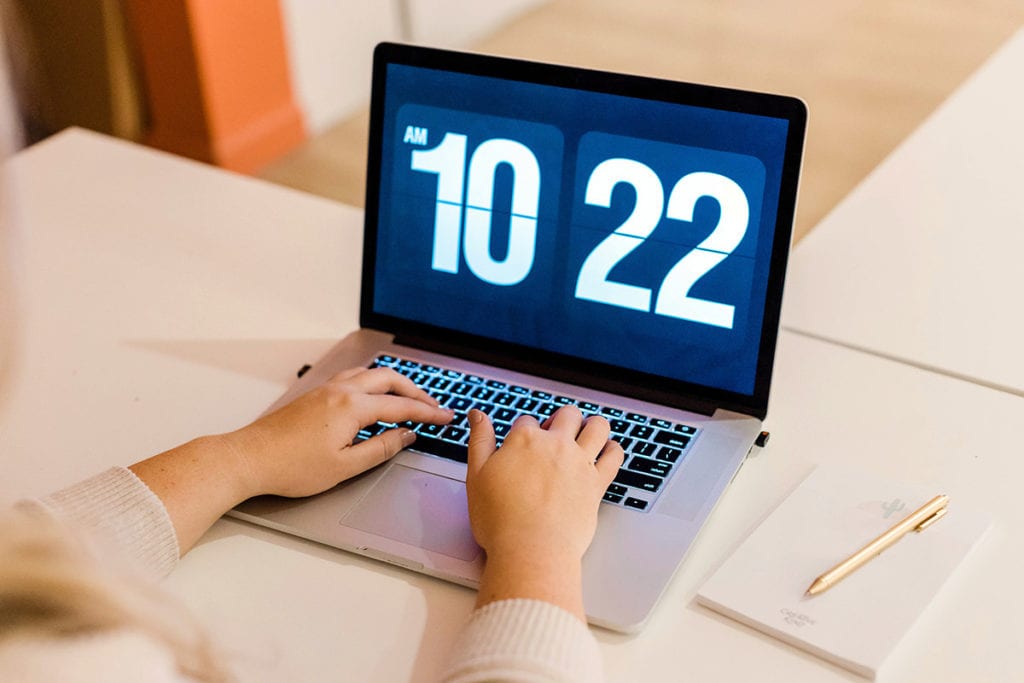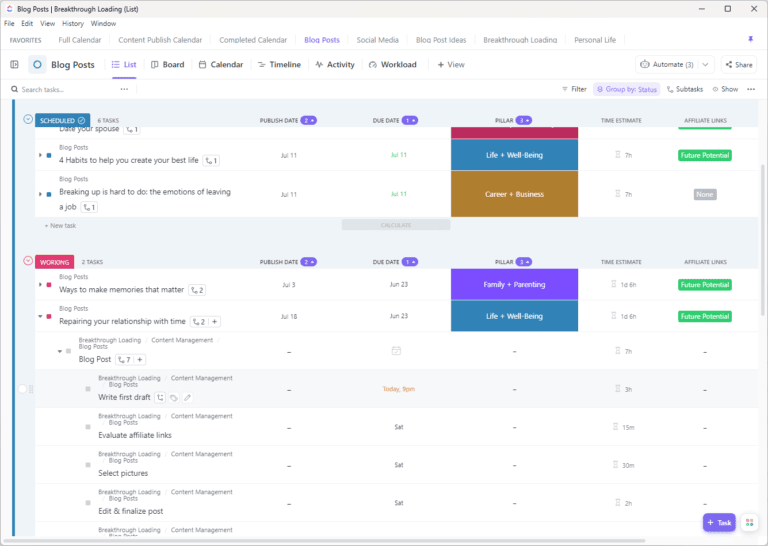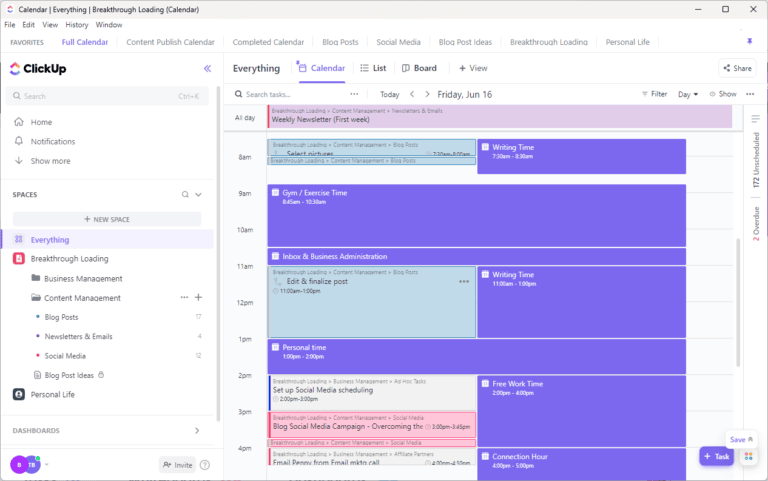Time is on Your Side: How to Use it Wisely with Priority Management
How often do you find yourself out of time? No matter how much you try to plan your calendar to use your time wisely and manage all your priorities, those fleeting hours still slip away too quickly. We all possess the same 86,400 seconds in a day, 10,080 minutes in a week, and 8,760 hours in a year as always. So how can you use your time wisely and make the most of every precious moment? Priority management.

*Disclosure: I only recommend products and services that I would use myself, and all opinions expressed here are my own. As an Amazon Associate and affiliate partner of certain other brands, I earn from qualifying purchases. This post contains affiliate links, which means I may earn a small commission (at no additional cost to you) when you sign up or make a purchase through these links. Please see the privacy policy and terms of use to learn more.
Time is not the enemy

“Time is free, but it’s priceless. You can’t own it, but you can use it. You can’t keep it, but you can spend it. Once you’ve lost it, you can never get it back.” -Harvey MacKay
We are quick to blame time (or the lack thereof) for our inability to complete everything on our to-do list. But take a step back and make an honest assessment of your personal time crisis and you might find that you’re using your old friend Father Time as the unlikely scapegoat for a much larger modern problem.
Because, as a society, most of us suck at prioritization. Yep, I said it.
While the status quo is “I don’t have time for that” when challenged to add yet another task to our hectic schedules, is that really an accurate statement?
Face the facts
The fact is, we all have the same 24 hours in a day. We all have the ability to choose how we spend that time and it is our decision when we choose to waste it. You always have a choice.
The point is, it is unfair to blame time for our lack of prioritization. It is not that you don’t have time, it is that you choose not to spend your time wisely. What you are really saying is “That is not a priority for me right now.”
Try exercising for 15 minutes a day to reduce stress and improve your quality of sleep.
- That is not a priority for me right now.
Take 10 minutes to sit with your spouse to catch up on your days.
- That is not a priority for me right now.
Spend 5 minutes a night reading with your children to help them settle into bed easier with a soothing routine.
- That is not a priority for me right now.
Ouch. Try those on for size. Stings a little bit, huh?
Time management is not the answer

“Lack of time is actually the lack of priorities.” -Tim Ferriss
It’s a common problem that the majority of us face every day. If you were to google “time management” right now the query would return a plethora of news and blog articles, each providing its own perspective and advice. But who has time to read all that?
In today’s hustle culture world that idealizes long hours and equates busyness with success, it would seem that the rise of time management hacks should be the answer to our overscheduled agendas’ prayers. But as recent critics highlight, time management is not your savior.
By increasing efficiency in a given amount of time we actually increase our capacity and ultimately our workload as well. We then turn back to implementing more time management tricks to stay afloat, and so on and so forth. This repetitive cycle continues on until we find ourselves burnt out beyond all repair. (And trust me, that burnout cycle is hard to break out of.)
Priority management versus managing time

While it is beneficial to create a plan to organize our time (more on that in a minute), evidence strongly suggests that the first step of time management is actually priority management.
In the 2018 release of Make Time: How to Focus on What Matters Every Day, authors Jake Knapp and John Zeratsky tout their “daily highlight” method. This method takes your massive task list (think big ticket items that require an hour or more, or that you have been dreading) and asks you to prioritize one highlight each day. That’s it — just one thing per day, amongst the other menial items, that we can look back upon and feel good about accomplishing.
While you don’t have to follow this approach to a “T,” there is something beneficial to assigning yourself a defined accomplishment (or plural, if you can swing it) every day that we can check off the list. The key is to focus on priority management over time management.
Define your priorities

The other beautiful component of this priority management approach is that you define what is a priority.
One day your priority will be to finish that big presentation for work. The next day your top goal is to get your kids to their dentist appointment on time and without tears. Don’t overcommit yourself to too many priorities, focus on what is most urgent or necessary on that given day, and be proud of yourself once you can check it off the list.
And yes, don’t forget to mark that spa day with your best girlfriend as a priority. Ensure your emotional tank is full should always be on your to-do list.
How to use your time wisely
So now that you have your list of doctors’ offices to follow up with, hair appointments you keep pushing back, and work assignments you’ve been dreading — let’s figure out how to implement priority management so you can get all the important stuff accomplished!
Create a system

As much as I love Post-it notes and steno pad grocery lists, when it comes to the bigger picture of managing a family and household, a career or a business, and life in general — you have to have a system in place. Being able to review, edit and organize your ever-changing list of responsibilities is critical to ensuring you are making the best use of your time while also not leaving stray tasks behind.
Use the right tools for you
There are so many helpful (and free!) digital tools nowadays to keep you organized, you just have to find one that works for you. Being a bit of a productivity nerd myself, I have tried my fair share of solutions to find the best fit for both my personal and professional life.
Ideally, you want a system that can be integrated with your calendar so you can align your tasks with your appointments. Evernote is a tried-and-true productivity solution that I have used for years that recently added a Google calendar integration in their premium offerings. If you currently use the Microsoft suite of products, OneNote is a great option to seamlessly incorporate your task list with your other email, documents, spreadsheets, and presentations.
My personal favorite productivity tool is ClickUp, which has become my go-to solution for both personal and business organization. Their motto is “One app to replace them all,” which I appreciate not only for the gentle Tolkien nod but also for the accuracy of their statement. Utilizing Clickup, I’ve been able to not only keep track of my personal tasks but also create an entire workflow for my business.

Whichever tool you decide to go with, make sure it’s sustainable over the long term. Your ideal organization system is going to be the one you keep up with.
Make a (flexible) schedule
Armed with your whittled-down and prioritized to-do list, sit down with your calendar and build in time to tackle the top items. This time-blocking approach is helpful to get an overall view of your day (or week or month) and assign tasks based on priority and efficiency. It can be used for every aspect of your life, from personal errands (think squeezing in a quick trip to the dry cleaners that happens to be around the corner from your child’s soccer practice) to work assignments (blocking an hour without meetings to complete that presentation you’ve been avoiding).
Utilizing my ClickUp task list with the incorporated Google calendar, I can always see my upcoming schedule and time-block my responsibilities when they make the most sense. Seriously, if you’ve never checked out ClickUp I highly recommend you give their free product a whirl. I guarantee it’s worth your time. (Pun intended.)

Account for the time that matters
Make sure you build in extra time throughout your days to absorb unforeseen delays or address any last-minute fire drills. Scheduling every second of every day with no flexibility will ultimately cause more stress in the long run. If you don’t need that flex time, great! Use that built-in cushion to tackle the next thing or give yourself a moment to relax.
It’s also very important you carve out some personal time to take a mental break, spend time with friends and family, or get in a quick workout. Time for yourself will not magically appear if you don’t plan for it and should always be considered a priority!
No matter how you decide to use your time, setting a realistic deadline (and sticking to it!) for your priorities is critical to tackling all your to-do’s. Don’t leave that checklist to complete itself — set a deadline, set a timeframe to complete it, and happily mark it off your list so you can move on to the next thing.
Work with your magic time

When do you feel your most productive and inspired? Early in the morning? Late at night? While you’re scrubbing the baseboards? Take note of when you’re most likely to make the magic happen and use this power hour to your advantage.
Have you ever tried to accomplish a dreaded assignment when you felt drained? Nearly impossible, right? Now how about taking on that same assignment when you were fresh and in the flow? Much better. By working with your brain’s natural rhythm instead of against it, you can accomplish much more in less time.
Try to schedule your most challenging tasks that require your focus and creativity during your magic time. Combined with time blocking, you can ensure you tackle these objectives as efficiently as possible with the best results.
Incorporate the right way to multi-task

As humans (and especially women), we love to claim that we are multi-tasking masters. You can’t be in two places at once, but at least you can do two things at once. That has to lead to some level of higher productivity, right?
Unfortunately, multiple scientific studies have concluded that the act of multi-tasking is a farce. Not only is your brain not equipped to handle two objectives at once, but quickly transitioning between tasks has been shown to actually slow down cognitive processing and lead to more mistakes. Has anyone else accidentally texted the wrong person while cooking dinner or corralling kids?
There is one type of multi-tasking that actually works. Combining repetitive actions with active recognition may actually provide that two-birds-one-stone ability. Because the physical activity does not require a lot of mental focus (think taking a walk or folding laundry), your brain is free to think about other things (such as an audiobook or your favorite reality TV show).
So if you are trying to carve out more time in your day (let’s be honest, who isn’t!) and focus on priority management, try multi-tasking the right way to be more productive when you can. Leave the rest of the time to engage and focus on one thing — you don’t want to have to apologize to Aunt Gertrude again for accidentally sending another offensively funny meme.
Time is on your side

It’s very clear that we have unfairly given time a bad rap as the pace of modern society continues to accelerate and demand more of our attention. But with some self-reflection, priority management, and careful planning, you can start to repair your relationship with the clock and learn how to use time more wisely in the future.
As the Rolling Stones lyrically remind you, time is on your side. Use your new ally to make the most of your days and create a life you love.
*ClickUp does offer premium subscription services suited to small businesses or larger organizations, but the completely free package offers all the bells and whistles any individual or family needs to stay on top of their busy schedule.
How have you tried to repair your relationship with time? What systems and hacks have you found to be the most effective in managing your schedule? Share your ideas in the comments below!





